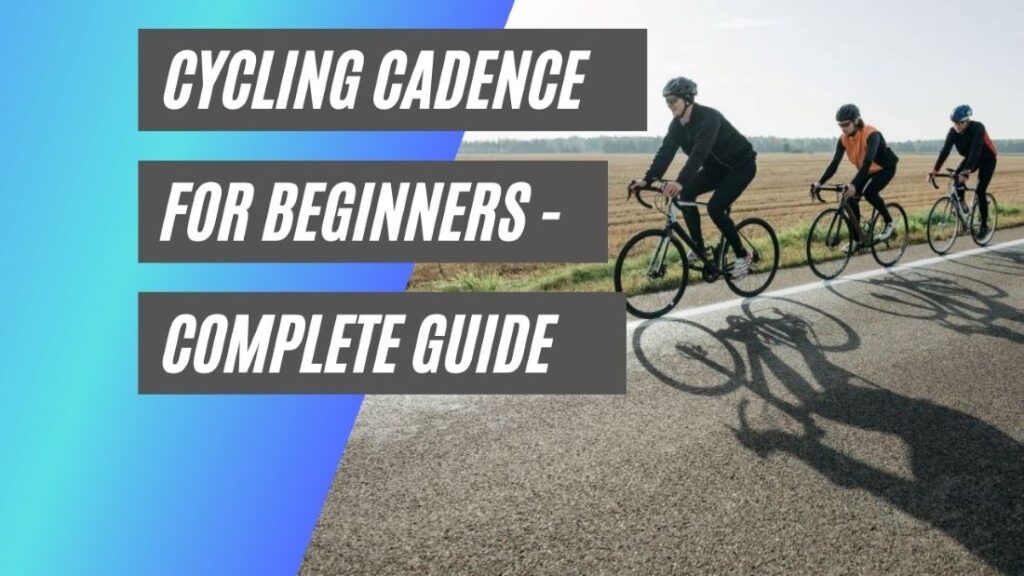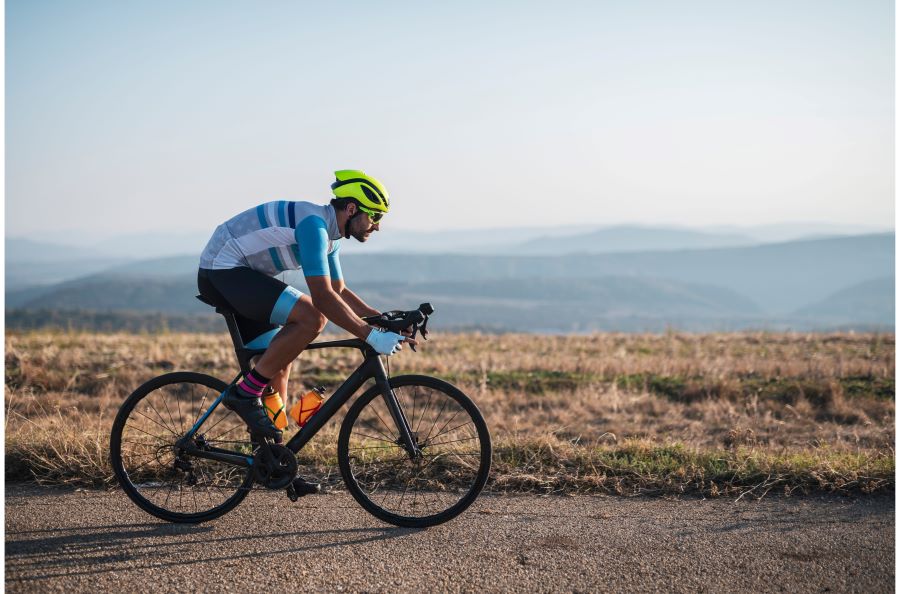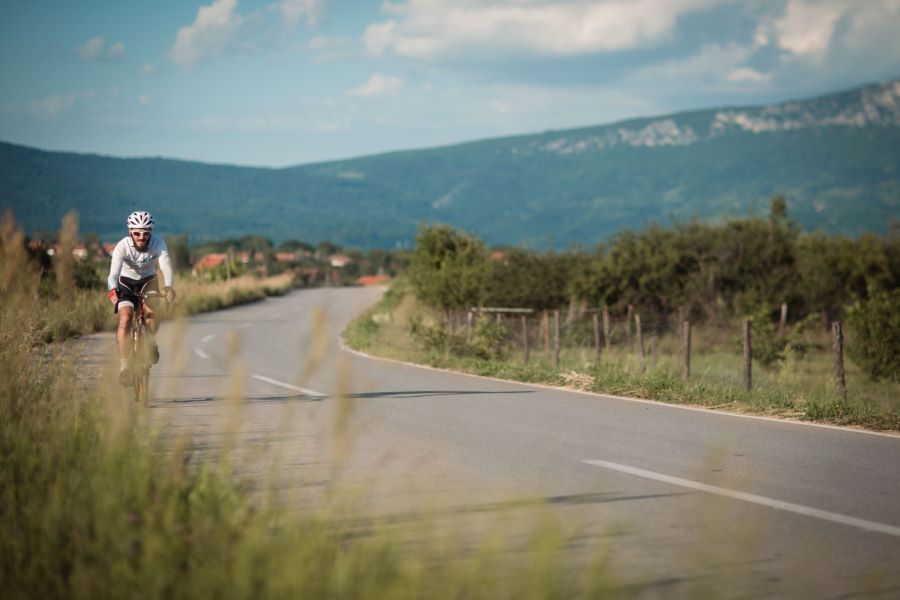This post may contain affiliate links. If you click an affiliate link and make a purchase, I may earn a commission. Also, as an Amazon Associate, I earn from qualifying purchases.--
New to the world of cycling, and looking for the fastest way to make progress?
The first thing to work on is your cadence. Whether you cycle regularly or occasionally, your cadence plays a huge role in helping you become a faster, stronger, and more efficient cyclist.
The best cycling cadence is around 85-90 revolutions per minute (RPM). However, most beginner cyclists begin cycling at an average of 60 RPM and will bring their cadence up to 85-90 RPM with continuous training.
In this article, I’ll go through exactly what cadence is, how to measure it, and most importantly how to improve it!

What Is Cadence in Cycling?
When you begin cycling for the first time, there’s an entire lexicon of jargon that you get to hear, and one of the most common terms you will encounter is “cadence”.
Contrary to what you might think at first, the concept of cadence is actually very simple.
Cadence is basically the rate at which you pedal your cycle. It tells you how many revolutions your pedals make per minute as you cycle.
Watch a skilled cyclist ride his bike and you will notice how he pedals extremely fast while gliding along his track so smoothly.
This apparent ease is largely achieved by the cyclist by focusing on his cadence over the years. His average cadence will generally be high – around 80-100 RPM.
On the other hand, a recreational cyclist will pedal much slower, at a rate of around 60 RPM or lower.
But does your cadence really matter if you are a beginner?
If yes, then what’s the ideal cadence a beginner should aim for and how can one measure their cadence?
Let’s take a closer look.
Why Is Cadence Important?
Cadence is an important measurement because it directly impacts the power you are able to produce on your bike.
The faster you pedal, the greater the power you generate on your bike and, thus, you maximize your efficiency.
Cycling at a low cadence puts a greater amount of strain on your muscles, allowing you to burn more fat for energy. When you pedal at a higher gear, you use up more energy trying to push the pedal, leading to muscle soreness after a couple of minutes.
On the other hand, if you pedal too fast as a beginner, you are much more likely to tire yourself out much quicker, thus lowering your efficiency.
This is why it is so important to focus on your pedaling technique and choosing the perfect cadence.

What Should My Cadence Be?
If you are new to cycling, then you should work on finding the right cadence at which you are able to achieve maximum efficiency. This will vary from person to person based on their cardiovascular health and their physique.
Well-built cyclists are much more comfortable riding at a lower cadence because they have a greater muscle mass that allows them to push the pedals much more easily.
In comparison, a lean rider with good cardiovascular health will opt to pedal faster with lesser force being applied with each stroke.
If you’re an amateur, you are more likely to pedal slower because you won’t be able to handle the stress a higher cadence puts on your cardiovascular health.
As a general rule, remember that if your legs start to tire out before you start gasping for air, increase your cadence.
Similarly, if your lungs give out before your legs do, lower your cadence. This general understanding of how cadence works will come to you much more easily with practice as you seek to find the right cadence for yourself.
Since every person is different, many factors will dictate what the right cadence is for them when they’re starting out. However, most beginners start out at an average of around 50-60 RPM.
If you’re new to the sport, you are likely to begin at this speed too.
What’s more, you can focus on your cadence training and improve your pedaling technique in order to increase this value in small intervals over a period of days.
Ideally, you should aim for a cadence of around 80-85 RPM in order to avoid muscle soreness and fatigue.
While there is a lot of evidence to support the concept that higher cadence in cycling is much more efficient, this idea may not be applicable to every cyclist.
A study1 by Formenti et. al. aimed to explore the effects of cadence on skeletal muscle oxygenation during cycling.
As a part of the study, nine healthy individuals with differing levels of cycling experience were asked to pedal at different cadences. Their cardiopulmonary and metabolic responses were monitored throughout this study.
The results of the study showed that after increasing their cadence above 90 RPM, the amateur cyclist’s efficiency started to drop.
This means that while cycling at a cadence of 90 RPM or more may be efficient for a professional cyclist, it may be disadvantageous for an inexperienced rider.
This is because pedaling at a high cadence tends to shift the load on your cardiovascular system and after a certain level of cadence, fatigue starts to kick in.
Probably the most important thing when it comes to cadence is the level of experience of the rider. Here is a simple table that breaks down the average cadence of a cyclist at different points in their career:
| Type of Cyclist | Average Cadence RPM |
| Beginner | 50-60RPM |
| Intermediate | 60-80RPM |
| Experienced | 80-100RPM |
| Professional | 100-120RPM |
How Do I Choose the Right Cadence?
The truth is that there is no ideal cadence fit for everyone.
The right cadence varies from one person to another and is largely determined based on the cyclist’s cycling experience, muscle fiber type, and cardiovascular fitness although road conditions and speed also play a crucial role as well.
If the wind is pushing you forward, you will have to adjust the gear to achieve the right cadence for you.
Similarly, if you are cycling uphill, you will have to adjust your cadence to help you get to the top.
This just shows that cadence depends upon a number of factors and every cyclist must choose what gear and cadence best suits their ride.
Ultimately, the greater amount of practice you have cycling in different circumstances, the better you can determine the suitable cadence for yourself.
How Do I Measure My Cycling Cadence?
Before you explore how you can improve your cadence, you should know what your current cycling cadence is.
After all, how will you know if you are cycling at a cadence of 70 RPM or 90 RPM?
Count Your Pedals
While some cadence tracking devices can tell you your cadence more accurately, you can measure your cadence yourself by simply counting the number of times your leg pushes down on the pedal for a total of thirty seconds.
This should be done while riding on flat terrain with no speed bumps or traffic signals.
Once counted, then double that number and you will have your cadence.
If you find it difficult to count for thirty seconds while riding, just count for 10 seconds and then multiply the number by 6 to get your cadence.
Ideally, you should repeat this process two more times and calculate their average to get a more accurate value of your cadence.
Remember that it is important to experiment with different cadences before you find what suits you best. A cadence that works for some may not work for others.
Similarly, the same cadence may not work for you in every situation.
You may need to learn how to adjust your cadence based on the type of surface you are riding on. Once you get used to what different cadences feel like, you’ll be more comfortable changing your cadence automatically to what better fits you.
Use a Cadence Sensor
Some bicycles also have sensors attached to them on the crank that help you ascertain your cadence for you.
These sensors give a much more accurate measurement of your cadence in real-time as you are riding your bike.
If you see your cadence going down while you are riding, you can simply crank up the pedaling speed or change into an easier gear.
If you want to maximize your efficiency, you should consider getting a cadence sensor so that you are able to gauge your efficiency while you ride.
By using data from your cadence sensor paired with that of your fitness tracking device, you can gain much more insight into your cycling workout and use it to figure out ways to improve your efficiency.

How Can I Improve My Cadence?
Once you’ve determined your cycling cadence, you can start working on ways to improve it. By enhancing your neuromuscular coordination on the bike, you can ride faster and longer before fatigue sets in.
By incorporating certain cadence drills in your regular training, you can improve your pedaling efficiency and neuromuscular coordination significantly, thus enhancing your cadence.
Here are some drills to help you enhance your cadence when you are first starting out.
High-Cadence Recovery
One of the best ways you can improve your cadence is by starting off with a cadence of around 80 RPM and then slowly pushing into a steady pedaling rate of 90 RPM for around 3-4 minutes.
Continue the drill by increasing your cadence to 100 to 110 RPM for at least 30 seconds.
Repeat this drill a number of times during your regular workout. This drill will not only help you build your stamina but also improve your overall cardiovascular health so that you can improve your natural cadence.
Endurance Spinning
Another way you can improve your cadence as a beginner is by cycling at a steady cadence of 70-80 RPM for 5-minute intervals at least three times with a 5-minute recovery break in between.
Slowly increase the cadence each day as you become more comfortable riding at a higher cadence in order to keep pushing yourself. This drill is designed to help you raise your natural cadence.
Rotating Cadences
Another tried and tested method of enhancing your cycling efficiency is to spend 30 minutes shifting between different cycling cadences ranging from 90 RPM to 120 RPM.
Hold each cadence level for at least thirty seconds or more. You may take a break of half this time between each interval.
Single-Leg Training
As the name suggests and as a part of this drill, you will be devoting all your attention to just one leg in order to amplify the power that you generate with each pedal stroke.
Focus all your attention on just one leg and pedal your foot forward for 90 seconds. Repeat the drill with the other leg.
Should I Train At Different Cadences?
Simply put, yes!
As a cyclist, you will inevitably encounter all kinds of situations on the road that may require you to adjust your cadence accordingly.
This can include long climbs, rugged terrains, steep descents, and rough weather too. All of these situations will require you to change your cadence accordingly.
However, if you’re not prepared to cycle at a different cadence outside of your comfort zone, you will likely get tired in these situations very easily. This is why practicing at different pedaling rates is so important.
It not only helps you to discover the right cadence that suits you but it also enables you to adapt to a wide range of cadences so that you can be ready for any situation that comes your way.
Practicing the cadence drills mentioned above can help you improve the quality of your pedal stroke and acclimatize to different cycling cadences.
The Bottom Line
By regularly focusing on your cadence training, you too can become a more efficient, resilient, and faster rider.
Practicing some simple high-cadence drills will place a greater amount of stress on your cardiovascular system, enhancing your overall physique and fitness and allowing you to build endurance.
References:
1. Formenti F, Dockerill C, Kankanange L, Zhang L, Takaishi T, Ishida K. The Effect of Pedaling Cadence on Skeletal Muscle Oxygenation During Cycling at Moderate Exercise Intensity. Int J Sports Med. 2019 May;40(5):305-311. doi: 10.1055/a-0835-6286. Epub 2019 Feb 8. PMID: 30736073.
